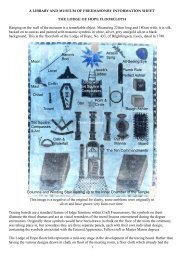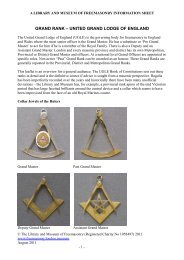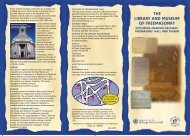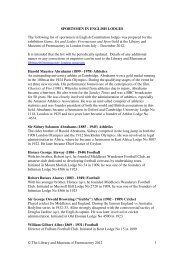FREEMASONS AND THE ROYAL SOCIETY Alphabetical List of ...
FREEMASONS AND THE ROYAL SOCIETY Alphabetical List of ...
FREEMASONS AND THE ROYAL SOCIETY Alphabetical List of ...
You also want an ePaper? Increase the reach of your titles
YUMPU automatically turns print PDFs into web optimized ePapers that Google loves.
Fellows <strong>of</strong> the Royal Society who are or were Freemasons, listed alphabetically<br />
Carpue, Joseph Constantine, FRS [13 Feb 1802] (bapt. 4 May 1764–30 Jan 1846), surgeon and anatomist, son <strong>of</strong><br />
Henry Carpue (†1794), a Roman Catholic gentleman <strong>of</strong> Brook Green and his wife, Catherine Lewis (†1797), and<br />
grandson <strong>of</strong> Charles Carpue (†1773), <strong>of</strong> Hammersmith, who had made his fortune as a shoemaker. He had<br />
‘impeccable Roman Catholic’ connexions, descended from a Spanish Netherlands family, under the patronage <strong>of</strong> the<br />
Roman Catholic Barons Dormer <strong>of</strong> Buckinghamshire, the 6 th Baron Dormer (†1761), being a Roman Catholic priest<br />
never used the title when he succeeded in 1728.<br />
Initially intended for the priesthood, 86 educ Jesuits’ Coll, Douai, embarked on continental tour 1782, seeing much<br />
<strong>of</strong> Paris before and after the French Revolution, and after thinking <strong>of</strong> working for his uncle, toying with the Bar and<br />
the stage, eventually decided on surgery, studying at St George’s Hospital, London. Served for 12 years as a staff<br />
surgeon at the Duke <strong>of</strong> York’s Hospital, Chelsea, resigning as he objected to serving abroad. From 1800–32 became a<br />
freelance anatomy teacher, charging a regular 20 guineas, giving 3 courses <strong>of</strong> daily lectures at 50 Dean Street on<br />
anatomy, twice weekly evening lectures on surgery. He had plenty <strong>of</strong> pupils for many years, but his school appears to<br />
have come to an end because <strong>of</strong> a lack <strong>of</strong> them. Became a proponent <strong>of</strong> vaccination, interested in medical electricity,<br />
publishing several technical medical papers from 1801–19, visiting many military depots to promote the new idea and<br />
joined George Pearson, with whom he had been associated at St George’s, as a surgeon at the Natl Vaccine<br />
Institution, where he remained until he died.<br />
Reformer, supporting many causes but strongly opposed the backward-looking Royal Coll <strong>of</strong> Surgeons who<br />
refused him a place on either its council or as an examiner. As a politician, characterized by his independent advocacy<br />
for reform and enjoyed the friendship <strong>of</strong> Fox, Sheridan, Nelson, Horne Tooke, Romilly, and others <strong>of</strong> the good and<br />
the great. Became a consulting surgeon at the St Pancras Infirmary and met and was much admired by George IV and<br />
attended his sister, Princess Amelia (1783–1810), 6 th dau <strong>of</strong> George III. He later lived at 45 Upper Charlotte Street,<br />
Fitzroy Square, but had another house at 21 Portland Place. Described as ‘clever but very eccentric’, ‘a tall ungainly,<br />
good-tempered, grey-haired man, in an unfitted black dress . . .’ and ‘a warm and faithful friend, abstemious and<br />
regular in his habits, and a great admirer <strong>of</strong> simplicity in manner and appearance’, ‘distinguished for affability,<br />
kindness and love to mankind’, ‘distinguished for high-mindedness, honour, integrity; in these great qualities he was<br />
unsurpassed’, and a man who ‘attained the highest character in his pr<strong>of</strong>ession. . . leaving behind him a reputation <strong>of</strong><br />
one <strong>of</strong> its most skilful members.’<br />
Married at Chiswick, 8 Jan 1799, when living in St Martin-in-the-Fields, Elizabeth Holland, dau <strong>of</strong> Thomas<br />
Holland <strong>of</strong> Chiswick, sister <strong>of</strong> the actor Charles Holland (1768–1849), and niece <strong>of</strong> Charles Holland (1733–1769),<br />
also an actor, and they had 5 daus. Suffered severe injuries in a train crash on the new London-Brighton line on the<br />
South-Western Railway, in which 2 <strong>of</strong> his servants were killed. He developed dropsy, from which he died, aged 81, at<br />
his Upper Charlotte Street home, ordering that his funeral should be <strong>of</strong> the simplest kind possible.<br />
Initiated 1788 in Paris, but nothing appears to be known as to which L. and the precise date there<strong>of</strong>. An<br />
appreciative obituary <strong>of</strong> him appeared in the Freemasons’ Quarterly Review, Mar 1846.<br />
Cartwright, Samuel, FRS [11 Feb 1841 (1789–10 Jun 1864), <strong>of</strong> 32 Burlington Street, London, dentist.<br />
Born at Northampton in 1789, he was originally an ivory turner, but came to London at an early age and<br />
commenced life as a mechanical asst to Mr Charles Dumergue <strong>of</strong> Piccadilly.<br />
During this service he found time to give a regular attendance on anatomical and surgical lectures. In 1811 he<br />
started in practice on his own account at 32 Old Burlington Street. During a great part <strong>of</strong> his career he was in the habit<br />
<strong>of</strong> seeing from 40 to 50 patients a day.<br />
Did much to improve and elevate his pr<strong>of</strong>ession, and is said for some years to have been in the receipt <strong>of</strong> an<br />
income <strong>of</strong> upwards <strong>of</strong> £10,000. Became FLS, 19 Nov 1833, and was also a Fellow, Geological Socy, but never found<br />
time to make any contributions to the Proceedings <strong>of</strong> these institutions. His pleasing manners, liberal hospitality, and<br />
pr<strong>of</strong>essional fame acquired for him the friendship <strong>of</strong> nearly all the most distinguished in science, literature, and art <strong>of</strong><br />
his day.<br />
Continued in practice at Old Burlington Street until 1857, when he retired, and in the following year had an<br />
apoplectic seizure which resulted in palsy, under which he laboured for the rest <strong>of</strong> his life. Died at Nizell’s House,<br />
near Tonbridge.<br />
Initiated, 10 Dec 1825, Royal Somerset House and Inverness L. No. 6, now No. 4, London. Joined, 20 May<br />
1831, 87 Prince <strong>of</strong> Wales’s L. No. 493, now No. 259, London. GStwd, 1836–37, 88 Pres, BdGStwds.<br />
Carvalho e Mello, Sebastian Joseph de, FRS [15 May 1740], later [1758] Count de Pombal, then [1770] Marquez<br />
[Marquess] de Pombal (13 May 1699–8 May 1782), Portuguese statesman and chancery minister.<br />
Born near Coimbra, Portugal, he was Portuguese Ambassador, first to United Kingdom, 1739, in London; then<br />
to Austria, 1745, in Vienna. On the recommendation <strong>of</strong> Maria Anne (Josephine) (1683–1754), 89 mother <strong>of</strong> Joseph<br />
[José] I, King <strong>of</strong> Portugal 1750–77 (1714–1777), Pombal became Prime Minister <strong>of</strong> Portugal, 1750, and undertook<br />
86 ODNB.<br />
87 The same day on which Philip Hardwick, RA, FRS [qv, below] was initiated.<br />
88 Dyer, 178, records that he represented Prince <strong>of</strong> Wales’s L., 1836–37, but he did not join GStwds’ L.<br />
89 Dau (by his 3rd wife, Eleanor Magdalena (1655–1720), dau <strong>of</strong> John Frederick, Duke <strong>of</strong> Brunswick-Lüneberg), Leopold I (1640–1705), Holy<br />
Roman Emperor 1658–1705.<br />
19










